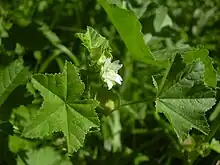Malva parviflora
Malva parviflora is an annual or perennial herb that is native to Northern Africa, Europe and Asia and is widely naturalised elsewhere.[1] Common names include cheeseweed,[1] cheeseweed mallow, Egyptian mallow,[1] least mallow,[2] little mallow,[1] mallow,[3] marshmallow,[3] small-flowered mallow,[4] small-flowered marshmallow[5] and smallflower mallow.[3] It typically grows on agricultural lands and in disturbed sites such as roadsides. [6]
| Malva parviflora | |
|---|---|
 | |
| Scientific classification | |
| Kingdom: | Plantae |
| Clade: | Tracheophytes |
| Clade: | Angiosperms |
| Clade: | Eudicots |
| Clade: | Rosids |
| Order: | Malvales |
| Family: | Malvaceae |
| Genus: | Malva |
| Species: | M. parviflora |
| Binomial name | |
| Malva parviflora | |
M. parviflora leaf extracts possess anti-inflammatory and antioxidant activities.[7] Under some conditions, the plant's leaves and seeds can be toxic to cattle and poultry due to an accumulation of nitrates.[6]
It has a decumbent or erect habit, growing up to 50–80 cm in height.[4][6] The broad leaves have 5 to 7 shallow lobes and are 8 to 10 cm in diameter.[4] The lobe edges are round toothed, with varying hairiness.[6] It has small white or pink flowers year-round at the base of leaf stalks; flowers have 4 to 10 mm long petals.[4][6] The 2 mm seeds are reddish-brown and kidney-shaped.[6]
Newly sprouted plants have hairless, heart-shaped cotyledons with long stalks. These cotyledons are 3–12 mm long and 3–8 mm wide. Stalks usually do have hairs. The first leaf is rounder and larger than the others. True leaves are round and weakly lobed with wavy, shallow-toothed edges and a red spot at the leaf base. The plant rapidly grows a deep taproot.[6]
References
- "Malva parviflora". Germplasm Resources Information Network. Agricultural Research Service, United States Department of Agriculture. Retrieved 2008-06-02.
- BSBI List 2007 (xls). Botanical Society of Britain and Ireland. Archived from the original (xls) on 2015-06-26. Retrieved 2014-10-17.
- "Malva parviflora". FloraBase. Western Australian Government Department of Biodiversity, Conservation and Attractions.
- "New South Wales Flora Online: Malva parviflora". Royal Botanic Gardens & Domain Trust, Sydney, Australia.
- "Malva parviflora L." Electronic Flora of South Australia Fact Sheet. State Herbarium of South Australia. Archived from the original on 2015-09-24. Retrieved 2008-06-03.
- "Little mallow (cheeseweed)". UC IPM. Regents of the University of California. Retrieved 17 May 2023.
- Bouriche H, Meziti H, Senator A, Arnhold J"Anti-inflammatory, free radical-scavenging, and metal-chelating activities of Malva parviflora." Pharm Biol. 2011 May 19;
External links
 Media related to Malva parviflora at Wikimedia Commons
Media related to Malva parviflora at Wikimedia Commons- "Malva parviflora". Neotropical Herbarium Specimens. Archived from the original on 2016-03-03. Retrieved 2008-06-20.
- GBIF: Occurrence data for Malva parviflora
- Jepson Manual Treatment
- USDA Plants Profile
- Malva parviflora in the CalPhotos photo database, University of California, Berkeley
- "Malva parviflora". Calflora. Berkeley, California: The Calflora Database.
- "Malva parviflora". Plants for a Future.